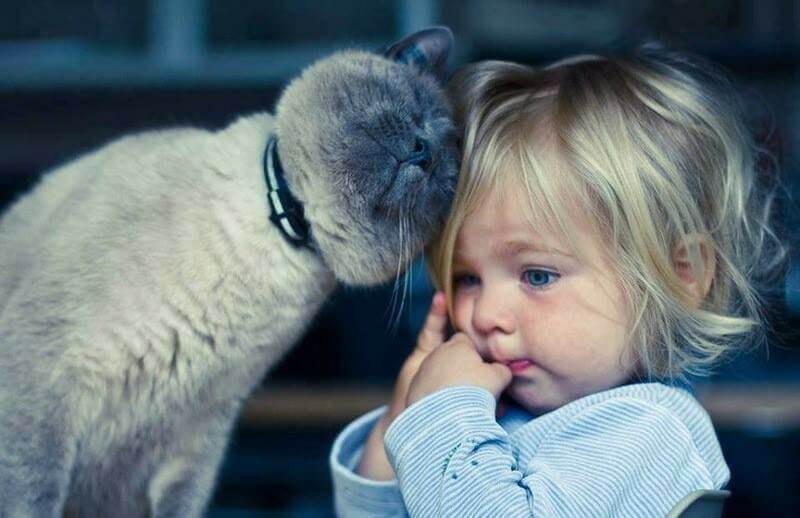Many people suffer from cat allergies, but can babies be affected too? And if so, how do you find out and what can you do?
Cats are the cause of allergies in many children, twice as often as dogs. However, during the first few years of life, cat allergies are very rare and usually manifest by the age of four. However, some children are affected much earlier.
Cat allergy is one of the most common allergic diseases to animals. Cats are the cause of 50% of all animal allergies. Contrary to popular belief, it is not the cat hairs that trigger the allergy, but the allergenic protein Fel d1 that the animals emit. Almost 10% of all Americans today suffer from a cat allergy and even the youngest are not spared from it.
Cat Allergy: Can The Baby Be Affected?

An allergy is a reaction in our immune system that causes inflammation when it comes into contact with allergens. In the case of a cat allergy, the aforementioned Fel d1 protein is responsible for causing the corresponding allergic symptoms.
When can the baby be allergic?
Babies can show the first signs of a cat allergy at an early age (cough, runny nose, sneezing, etc.). However, some of the conventional tests are not suitable for infants. The very little ones usually have an allergic runny nose or rhinopharyngitis. So you show the same symptoms as with a respiratory allergy.
If the child has a recurring runny nose or coughs frequently at night without having a fever, this could be an indication of asthma of allergic origin. If in doubt, you should always contact your pediatrician.
Baby Allergic to Cat: Symptoms
As a parent, certain symptoms should warn you about which it is best to consult an allergist. These symptoms are common signs of an allergy in an infant:
- Runny nose;
- Frequent sneezing in a row;
- Itchy eyes;
- Inflammation of the eyes;
- Rashes;
- Cough or wheezing at night or while napping;
- Asthma.
In the case of an allergy, these symptoms usually occur after direct contact between the child and the animal, for example after playing or cuddling. Some children, who are particularly sensitive, can show the first symptoms as soon as they enter a room where an animal has been. Still, others show allergic reactions when they come into contact with cat owners.
Cat Hair Allergy: Prevention is Essential
In the event of a proven allergy or if you suspect a cat allergy in your baby, you should make sure that the area around the child is as free of any allergens as possible. Here are a few helpful hints:
- Avoid contact between child and pet.
- Set up an air freshener with a carbon filter.
- If the child has had contact with the cat, you should wash their hands thoroughly afterward.
- Ventilate the apartment for 5 to 10 minutes every day.
- Vacuum regularly with a vacuum cleaner with a filter.
- Do not let your cat in the child’s room.
- Bathe your cat regularly and wash its sleeping area (once a week).
- Comb your pet regularly to remove dead hair.
- Treat your cat with an antiallergic lotion that neutralizes the Fel d1. You can find these at the pet store or from your veterinarian.
- Make sure that there are a few dust traps as possible in your home. Remove carpets and carpeting and use washable materials.
Cat Allergy in Babies: Which Treatment is Best?
If you suspect your baby may be allergic, your pediatrician will refer you to an allergist.
Puncture test for cat allergies
This can, for example, carry out a so-called skin puncture test. A drop of the allergen is placed on the child’s skin with a tiny needle to find out if there is an allergic reaction. Puncture tests can be carried out immediately after birth, but are usually done for the first time at six months.
Nasal sprays and eye drops
Once the diagnosis is made, a specific treatment for the baby can be developed. There are nasal sprays and eye drops available that can help relieve allergy symptoms in your child. Antihistamines can also be administered once or twice a day in the form of a syrup. There are also healing and preventive homeopathic remedies, such as Allium Cepa 9CH, which can significantly alleviate the symptoms of allergic rhinitis.
In the case of a confirmed cat allergy, there are some preventive and treatment measures that can make it easier for your child and your cat to live together. However, a study by the University of Alberta also found that the earlier children come into contact with animal hair, the less often they later develop allergies.

